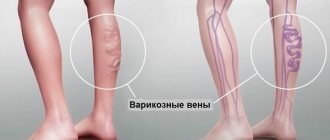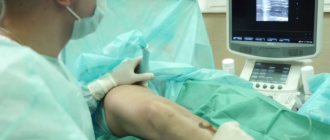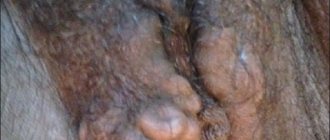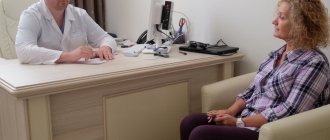- home
- Services and prices
- Phlebology
Varicose veins (VV) is a fairly common disease that affects both men and women. It can affect the lower limbs of a person, as well as deep veins, leading to the development of thrombosis and post-thrombophlebitis disease.
Spider veins that appear on a person’s legs as a result of the development of the disease become the reason that he begins to feel unattractive. In addition to external ones, there are also internal manifestations of explosives, which are expressed in the appearance of discomfort and pain in the calf muscles of the leg. The development of the disease increases the risk of other pathologies of the circulatory system.
The key to success in the fight against pathology lies in timely diagnosis and competent treatment. A big mistake on the part of a person is the independent use of various ointments and creams, which in most cases do not bring the desired effect. As a result, time was lost that could have been spent on proper and effective therapy.
In order to get rid of varicose veins, you need to solve the following problems:
- Elimination of symptoms.
- Removal of varicose veins.
- Prevention of the development and reappearance of explosives.
Only a highly qualified specialist with sufficient experience in the treatment and prevention of pathologies of this kind can successfully cope with each of the above tasks. These are the specialists who work at the Yuzhny Medical Center. The high level of qualifications of doctors in combination with the latest equipment will make it possible to make the correct diagnosis and carry out competent therapy, guaranteeing the absence of progression or recurrence of varicose veins of the lower extremities.
Symptoms of varicose veins
Symptoms of a disease are signs that clearly indicate its development. They are divided into:
- Subjective: Mild and aching pain in the calf muscles.
- A burning sensation and itching along the veins affected by varicose veins.
- Heaviness in the legs, increasing towards the end of the day.
- Skin hyperpigmentation.
- Increased fatigue of the lower extremities.
- Trophic venous ulcer of the leg.
- Pain in the calf muscles, aggravated by walking.
- The appearance of swelling in the lower legs and feet.
- Varicose veins of the saphenous veins, which are clearly visible even without the use of special equipment.
What veins look like
The very first warning sign of problems with the veins is swelling of the lower extremities at the end of the day. Swelling is especially pronounced if a person spends most of the day standing on his feet. It can disappear in the morning after a night spent resting.
However, if you do not pay due attention to this problem, the condition can worsen significantly. Intradermal veins in the legs with varicose veins become dark blue, protruding above the surface of the skin of the legs and feet. Outwardly, they look like bunches of red grapes that are overripe. Such external manifestations of pathology are accompanied by pain in the calves, a feeling of heat in the legs, swelling and cramps in the calf muscles. Over time, these symptoms are accompanied by a change in the appearance of the skin.
Pressotherapy – pneumatic compression as a method of conservative treatment
This technique is quite effective in relieving symptoms of varicose veins such as swelling, heaviness and nighttime venous cramps. The operating principle of pressotherapy is the mechanical removal of fluid in the lower extremities using local action of variable compression. And it’s stupid to argue about the effectiveness of the pressotherapy technique; it is not disputed by modern specialists. At the same time, it is necessary to recognize the fact that this technique itself contributes only to a temporary improvement in the patient’s condition. Varicose veins remain, and varicose veins continue to progress.
Causes of varicose veins of the lower extremities
VV of the lower extremities can develop under the influence of a number of factors and circumstances, the main ones being:
- Pregnancy. This is a key risk factor for the disease. This explains the fact that varicose veins occur several times more often in women than in men. In this case, the disease develops under the influence of an increase in the volume of circulating blood and compression of the retroperitoneal veins of the pregnant uterus.
- Obesity. The connection of this condition with the development of VV has been proven by a number of studies. At the same time, a direct connection was found between increased body weight and an increased risk of developing pathology.
- A lifestyle characterized by prolonged static loads with regular heavy lifting or prolonged immobility in a standing or sitting position.
- Dishormonal conditions. Their role in the development of the disease has increased significantly over recent years. This is due to the widespread use of hormonal contraceptives, the spread of hormone replacement treatment for osteoporosis and during the premenopausal period
- Heredity. The role of this factor in the development of varicose veins on the legs has not been unambiguously confirmed today.
- A disorder of the valvular apparatus of the veins, leading to a downward flow of blood under the influence of gravity every time a person stands up. The muscles that are located around the deep veins contract as you walk. These veins are subject to emptying, causing venous pressure to increase. Blood enters the superficial veins through communicating vessels with insufficient valves. As a result, they are filled with blood, which leads to their stretching and expansion (varicose veins).
Spider veins: treatment, drugs
Today, there are several effective methods for relieving the symptoms of the capillary network or completely removing the venous pattern. The most common type of therapy is considered a conservative treatment method, which involves taking pills and systemic medications. The goal of this therapy is to prevent progression of the disease and relieve pain. It is usually prescribed when minimally invasive procedures - sclerotherapy and EVLO - are impossible.
What is recommended as part of systemic therapy:
- Taking venotonic drugs – drugs based on bioflavonoids, which help normalize microcirculation, eliminate blood stagnation and increase vascular tone. The most effective drugs in this group are Phlebodia 600, Detralex, and Venarus.
- Compression underwear are special tights, stockings or socks with a certain degree of compression, which relieve stress from the lower extremities and take on the responsibility of evenly distributing blood throughout the vessels.
- Ointments and gels for external use are local agents that act directly on the site of skin lesions. The medicine quickly and effectively relieves symptoms and pain. As a specialist’s recommendations, you can use the ointment “Troxevasin”, “Hepatrombin”, “Heparin”.
- Tablets for strengthening the vascular wall - this group of products is based on multivitamins with vitamins C and P. This complex allows you to improve the structure of the venous bed, thin the blood and restore the density and elasticity of blood vessels. To obtain a long-term effect, the tablets are taken in courses with a break of six months.
The most effective way to minimize the risks of the appearance of “stars” on the legs and prevent their appearance is to prevent the disease. It should include moderate physical activity, a healthy diet, the absence of bad habits and the choice of comfortable clothes and shoes.
Classification and stages
Like any disease, VV has several stages, differing from each other in the degree of spread of the pathology and symptoms. Among them, the following stages are distinguished:
- Initial (or compensation).
- Second (or subcompensation).
- Third (or decompensation).
A detailed description of each stage can be found here.
It is worth noting that complications can occur at any of the above stages, but their greatest likelihood is inherent in the last two. VV can serve as an impetus for the development of diseases such as:
- Thrombophlebitis.
- Erysipelas.
- Deep vein thrombosis.
- Trophic eczema.
A visit to a specialist, made at the first signs of the disease, will help reduce the risks of worsening the situation and begin removing varicose veins. You should not ignore even minor symptoms, because this can lead to undesirable and extremely negative consequences.
Rating of tablets for varicose veins
Only a competent doctor – phlebologist – should prescribe tablets for varicose veins. Pharmacy chains offer a large selection of analogues in terms of composition or principle of action, which makes it difficult for the buyer to choose. Experts examined several dozen imported and domestically produced medicines, assessing each one based on a group of criteria:
- Group – venotonics, angioprotectors, disaggregants, phlebotonics, antioxidants;
- Composition – active ingredient, additional substances;
- Bioavailability – degree of digestibility;
- The result is an increase in the tone of the veins, relief of inflammation, relief of symptoms, etc.;
- Recommended for: children, adults, elderly people;
- Efficiency – at the initial, middle, last stages of varicose veins;
- Comfort – ease of use of tablets, course duration;
- Risks – contraindications, likelihood of side effects;
- Speed of action - how quickly the clinical manifestations of the disease subside;
- Compatibility – with alcohol, food, other medications;
- Sale - availability in pharmacies, prescription or free.
Experts also compared three important indicators – manufacturer, price, efficiency. Those candidates with the best harmony between them were included in the review. And real patient reviews, which indicate the pros and cons, helped weed out less effective, unreasonably expensive drugs.
The best pills for high blood pressure
Diagnostics
Diagnosis of varicose veins, the symptoms of which are described above, poses the following tasks:
- Determining the presence of pathology in each individual patient. It often happens that people who do not have varicose veins are confident in their presence, and vice versa. However, only an experienced phlebologist, based on an external examination and a series of comprehensive studies, can make an accurate diagnosis.
- Establishing the type characteristic of venous pathology. The doctor determines exactly which veins have undergone pathological damage, and also establishes the extent of this damage and possible or already occurring consequences.
- Prescribing the correct course of treatment. Based on the diagnosis and the characteristics of each specific organism, the attending physician makes a choice in favor of one or another treatment or a set of therapeutic measures.
- Assessment of the level of effectiveness of therapy, which is carried out by the attending physician during the elimination of the disease or after the patient’s complete recovery.
The main methods for diagnosing VV include:
- Plethysmography.
- Thermography.
- Magnetic resonance imaging.
- Ultrasound angioscanning.
- Computed tomography.
- Clinical studies: conversation with the patient, his external examination and manual examination.
- Radionuclide phlebography.
- Intravascular ultrasound.
- X-ray phlebography.
Most often, it is enough for a professional specialist to conduct a clinical examination and ultrasound angiography in order to diagnose varicose veins in the legs. At the Yuzhny clinic, you can undergo a full examination in order to make an accurate diagnosis by an experienced phlebologist. Our specialists work closely with clients, clearly explaining to each of them the specifics of the disease and possible ways to combat it.
Which brand of tablets for varicose veins is better to choose?
The main indicator of the quality and effectiveness of any product is the manufacturer. Its reputation and operating principles can tell a lot about the product in absentia. Therefore, before starting a detailed review of drugs, get acquainted with pharmacological companies. The best pills for varicose veins were presented by:
- Servier (Detralex) is an international independent pharmaceutical company that was founded in France in 1954. Provides innovative medicines to treat over 100 million people worldwide. This is one of the foreign companies that have localized the production of medicines at their own enterprise in Russia.
- JSC Pharmaceutical Enterprise Obolenskoye (Venarus) - the company was founded in 1994 in Russia on the basis of the State Center for Applied Microbiology. Today, production capacity is increasing - over 600 million tablets and capsules annually. The product portfolio includes 91 names for the treatment of cardiovascular pathologies, gastrointestinal diseases, allergies and other areas.
- Laboratory Innotek International (Phlebodia) - the laboratory is part of the French group. We are talking about a family company founded back in 1913. It specializes in medical and parapharmaceutical products. Since 1995, representative offices have been operating in Russia.
- Novartis (Glivenol) is a group of companies that was founded in Switzerland in 1996 amid the merger of Ciba-Geigy and Sandoz. The group includes 6 brands - Pharma prescription and OTC over-the-counter drugs, Alcon for vision protection, Sandoz biostimulants and generics, Vaccines and Diagnostics test systems and vaccines, Animal Health veterinary products. It ranks second in the world in terms of activity and market share in Europe.
- Boehringer Ingelheim (Antistax) is a family-owned pharmaceutical company that was founded in 1885 in Germany. Today it is one of the top 20 leading global drug production companies. Representative offices operate in 142 countries, including Russia.
- CJSC "Canonpharma Production" (Diosmin) is a company of a new generation of Russian manufacturers, operating since 1998. Complies with modern quality standards and advanced trends in the development of the pharmaceutical market. Effective and safe medications are used to combat a wide range of diseases.
- Balkanpharma-Troyan (Troxevasin) is a Bulgarian company that is part of the international pharmaceutical holding Actavis. Founded in 1998. All manufactured drugs undergo clinical and laboratory tests before going on sale. There are over 40 items on the Russian market.
- Pharma Wernigerode GmbH (Eskuzan) is a German pharmaceutical company that was founded in 1903. Today it is considered one of the most important companies in East Germany. The product portfolio includes all forms of medicines certified according to European standards.
- Nycomed GmbH (Actovegin) is a German company that began its activities in 1874. In Russia, the first representative office was opened in 1993. Offers effective medicines for all areas of medicine. In terms of sales volume, it is among the 30 largest companies in the world.
The best tablets for lamblia
Treatment methods
Modern methods of treating varicose veins are aimed at reducing the degree of disability and trauma, which contributes to a faster recovery of the patient. Main therapeutic techniques include:
- Sclerotherapy. This method involves introducing a special medication into the lumen of varicose veins of the legs, causing a chemical burn of the internal venous wall. This leads to their gluing and cessation of pathological blood flow through them. Can be used alone or in combination with other types of manipulation. It is carried out without prior anesthesia with skin punctures using a thin needle. The duration depends on the scale of the lesion.
- Foam sclerotherapy, which involves the preparation by a specialist of a special medication of foam that can use an impressive area of the internal walls of the affected venous vessels. Used to treat large diameter veins.
- Endovenous laser coagulation, which is performed using a laser device on the main trunks of the leg veins and allows you to stop the pathological flow of blood through the affected veins due to the burn of their inner walls and their subsequent gluing. Laser treatment for varicose veins is available at the Yuzhny Medical Center.
- Miniphlebectomy, aimed at eliminating subcutaneous nodes and tributaries enlarged by varicose veins through punctures of the skin. It has excellent cosmetic effects and is used alone or in combination with other therapeutic methods under local anesthesia.
- Elimination of incompetent perforating veins, performed for the prevention of venous insufficiency and treatment of trophic disorders, including ulcers.
- Combined phlebectomy, which is a combination of some methods of treating veins, based on the indications and nature of venous pathologies.
Yuzhny Medical Center offers its clients modern approaches to the treatment of varicose veins. Qualified specialists work here, ready to conduct a competent examination in order to make a diagnosis and carry out effective treatment, more about which you can read here.
Are modern tablets and capsules for the treatment of varicose veins really so ineffective?
The modern pharmaceutical industry offers a large selection of good and high-quality drugs for oral use in the treatment of varicose veins. These agents have significant and proven effects in the treatment of swelling, heaviness, venous pain, cramps and discomfort associated with chronic venous insufficiency.
Modern venotonic - Detralex
But do these drugs treat varicose veins themselves?
A pathologically altered vein is a hollow tube with thinned walls and non-functioning valves. The best treatment, in theory, would be organic restoration of the venous vessel with normalization of the valve apparatus. It’s just that irreversible degenerative changes have already occurred in the venous wall. Today, at this stage of development of modern medicine and pharmacy, there are no effective ways to restore varicose veins, either with the help of interventions or tablets and capsules. Work in this direction is underway, but its effectiveness still leaves much to be desired. Perhaps the dream of restoring a vein destroyed by varicose veins will come true in the coming decades, but we live not in the future, but in the present.
Complications with varicose veins
It is worth understanding that improper treatment of the disease or complete refusal of it can lead to complications. The latter appear not only in cosmetic defects of the lower extremities, but also in more serious forms. Among them:
- Trophic eczema, which subsequently develops into an ulcer.
- Thrombotic lesions of the venous system, including thrombophlebitis of the superficial veins and deep vein thrombosis of the lower extremities.
Venous blood is a kind of “sewer” for the body’s tissues and is saturated with substances and products of cell metabolism that are relatively harmful to the human body. Cells of the skin and subcutaneous tissue, as well as muscles and bones, discharge products of tissue respiration and other waste material into the venous system, which carries them to the heart, lungs, kidneys and liver. In case of disturbances in the functioning of the venous system, the content of these products in the tissues of the body increases.
A vein dilated by varicose veins leads not only to an increase in the concentration of harmful products in the tissues, but also to an increase in their swelling. This disruption of the outflow of harmful products, combined with swelling observed over a long period of time, leads to the death of skin cells and subcutaneous tissue and their subsequent replacement by venous eczema, represented by a dense and dotted structure of a dark color. The death of the surface layer of the skin is the cause of trophic ulcers.
Conservative therapy using compression hosiery (socks or stockings)
This another common form of conservative therapy involves the use of compression products.
Compression socks or stockings are often used in the conservative treatment of varicose veins. Compression hosiery quite effectively helps to cope with subjective complaints of varicose veins, such as pain, discomfort, and a feeling of swelling. Compression is also definitely effective in combating the objective symptoms of varicose veins: swelling, progression of trophic disorders. Conservative compression therapy, even on its own, can lead to regression and healing of a venous trophic ulcer. The positive effect of compression for varicose veins has been proven for a long time, and no one argues with this. However, the use of compression hosiery, even in combination with the best venotonics, can provide only a temporary and rather unstable effect. Trying to treat the patient only conservatively, with the help of compression, he is doomed to lifelong wearing of compression products and frequent visits to the doctor. When you stop using compression products, the disease returns in its previous forms, and sometimes in brighter colors.
Prevention
Varicose veins on the legs, which are treated today using various methods, can be avoided by following preventive measures. Due to the fact that the risk of developing VV is much higher in women, it is they who need to not ignore the prevention of this disease. However, men should also not ignore preventive measures aimed at preventing the development of varicose veins in the legs. Key activities include:
- The use of local preparations (gels, ointments, creams) that help strengthen the walls of blood vessels, optimize the functioning of valves, reduce the risk of blood clots, eliminate swelling and heal wounds.
- The use of knee socks, tights, stockings and elastic bandages that have a compression effect. This is an excellent tool in the fight against varicose veins. These products can be purchased in specialized stores after consultation with a doctor, which is necessary due to the relative difficulty in independently determining the required type of compression garments.
- Specific exercises performed on a daily basis. They are able to stop even the dilation of blood vessels that has already begun. It should be borne in mind that if you have a tendency to BB, you will have to give up heavy physical activity, but in no case should you ignore an active lifestyle. For example, light jogging, swimming, yoga and skiing help maintain healthy leg veins.
- Preventive tablets for varicose veins are recognized as a more effective method of preventing VVs than the use of local drugs. However, any oral medication should be used only as directed and under the strict supervision of a competent specialist.
In order to prevent the situation from worsening, you should stop self-medicating at the first manifestations of the disease and consult a doctor. This will make it possible to make a correct diagnosis in a timely manner and prescribe adequate treatment, which will stop the progression of the disease and reduce to zero the risks of developing other pathologies.
Creams and gels for varicose veins
Despite the high effectiveness promoted by sellers and manufacturers, creams and gels do not bring relief from varicose veins and dilated veins do not disappear from them. At the initial stage of venous insufficiency, the doctors conducting the consultation do not strongly object to the use of these supposedly “phlebotropic” drugs, since rubbing them acts like a light massage and promotes venous outflow, and has a calming effect on the skin and walls of blood vessels. In advanced forms of venous insufficiency, these creams and ointments can cause dermatitis and allergization, and are therefore very harmful. Gel "Lioton" and other heparin agents are used in the development of acute thrombophlebitis and help to subside the inflammatory process, but varicose veins do not disappear from them. Shamanic products like “Sophia with leeches” have become very popular thanks to proper advertising with beautiful women’s legs, but they have no relation to medicines, to women, or even to leeches and one can’t expect any sense from them. And also, regardless of the price, rating or well-known name, no drops will bring results, even if absolutely all the reviews talk about the drops as the best and inexpensive medications in the world, phlebotonics, which cure 100% of patients. The best solution would be to contact a good doctor who will prescribe comprehensive minimally invasive or drug treatment and correct your lifestyle.
FAQ
Very often people are interested not only in the question of how to treat varicose veins. Many patients suffering from this disease are interested in what they can do and what they cannot do, in order not to worsen their health condition and not provoke the emergence of other health problems. Below are frequently asked questions of interest to people with VV.
Is it possible to get vaccinated against coronavirus if you have varicose veins?
The answer to the question of whether coronavirus vaccination is allowed for varicose veins is yes. This pathology is not a limitation for vaccination against COVID-19 in the absence of its exacerbation. If a person does not suffer from acute thrombophlebitis, then this refers to decompensation of varicose veins of the legs, and he is not prohibited from being vaccinated against coronavirus infection.
Is it possible to drink coffee if you have varicose veins?
Caffeine has the ability to increase blood pressure and increase heart rate, which are unfavorable factors for fragile, swollen veins damaged by varicose veins. Coffee has the following effects on blood vessels:
- Increased load on the vein walls.
- Increased blood pressure.
- Short-term venous expansion.
Therefore, with varicose veins, you can drink coffee, but not exceeding the daily norm. Completely giving up your favorite tonic drink will not lead to the restoration of veins affected by pathology, so you should not torture yourself and not drink coffee. You just shouldn't drink more than 1-2 cups a day. It is also recommended to dilute coffee with milk.
Is massage allowed?
Comprehensive treatment of varicose veins at an early stage includes massage. However, it requires proper execution.
For varicose veins, you can only do a light massage of the lower extremities. It is also indicated for patients with uncomplicated forms of varicose veins.
It is advisable to perform a professional manual massage for patients with varicose veins, but it is imperative to take into account all the features of the course of the disease. It is recommended that you consult with a specialist before you begin massaging the area where the veins are affected by varicose veins.
Is it possible to warm your feet?
When the legs are heated, the veins expand, blood circulation increases and the load on the venous walls only increases. This can worsen the already poor condition of varicose veins. This is why it is recommended to limit hot baths for patients with varicose veins. It will be better to reduce the temperature of the water from hot to warm, which will not cause vasodilation and will not lead to a worsening of the person’s condition. You should always remember that consultation with a specialist is necessary regardless of whether we are talking about hot baths or vaccination for varicose veins.
Are running and squatting allowed?
Experts recommend starting jogging at the first signs of developing VV. It is important to ensure that these activities are systematic. During running, the blood is saturated with oxygen. Therefore, it is better to give preference to jogging in the forest or park, where the air is always clean.
However, you should adequately assess your capabilities and endurance, and avoid excessive stress, which is contraindicated for varicose veins. It is important to monitor a gradual increase in loads that do not exceed values that are comfortable for the body.
A person with BB should not feel tired while jogging. Only short-distance running using compression socks is allowed. In case of thrombophlebitis, jogging should be avoided. The admissibility of running and squats with pelvic varicose veins should be discussed with your doctor.
What is the best treatment for varicose veins?
Today there is no clear answer to the question of which therapeutic method is the most effective for varicose veins. The fact is that success in treatment depends on a number of factors that must be assessed by a qualified specialist in each specific case. Only after this can they make a final decision on prescribing one or another treatment for IV.
In order to prevent the situation from worsening, you should stop self-medicating at the first manifestations of the disease and consult a doctor. This will make it possible to make a correct diagnosis in a timely manner and prescribe adequate treatment, which will stop the progression of the disease and reduce to zero the risks of developing other pathologies.
What can replace venotonic tablets and capsules?
The only truly effective and efficient treatment for varicose veins at present is vein removal. Innovative interventions have transformed from serious operations to easy and safe outpatient procedures. One or two hours in the clinic and a serious problem with a long history is solved. It’s paradoxical, but modern innovative treatment for varicose veins is not only safe and comfortable, but also much more effective than a classic operation that has been proven for decades.
Modern treatment of varicose veins using sclerotherapy
Do not think that modern drugs are useless. They perfectly perform their functions in the complex treatment of venous pathology. However, treating varicose veins only with tablets and capsules is, at a minimum, not professional.
Which tablets for varicose veins are best to buy?
All 9 nominees in the rating demonstrate high quality, positive results, and a large percentage of positive reviews from customers. This raises the question, what pills to take for varicose veins and what is better to buy from the list presented? Experts insist on consulting a doctor, and also summarize the following review results:
- Detralex - good value for money, quality and effectiveness;
- Troxevasin is the most purchased drug, increasing local immunity;
- Aescusan is an effective drug for the prevention of thrombosis;
- Phlebodia – high safety, the best choice for pregnant women;
- Actovegin is an antihypoxant with metabolic properties;
- Glivenol is the most effective tablet for any stage of varicose veins.
It is possible to select effective medications against varicose veins only after examining the patient in a clinical setting. The individual characteristics of the body, concomitant disorders, existing symptoms, and age are taken into account. Self-medication with such a diagnosis is unacceptable, as it leads to serious complications.











